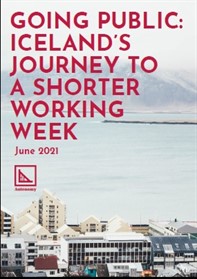Iceland’s Journey to a Shorter Working Week
Gudmundur D. Haraldsson, a researcher at Alda:
The Icelandic shorter working week journey tells us that not only is it possible to work less in modern times, but that progressive change is possible too.
Our roadmap to a shorter working week in the public sector should be of interest to anyone who wishes to see working hours reduced.
Will Stronge, Director of Research at Autonomy:
This study shows that the world’s largest ever trial of a shorter working week in the public sector was by all measures an overwhelming success. It shows that the public sector is ripe for being a pioneer of shorter working weeks – and lessons can be learned for other governments.
Iceland has taken a big step towards the four-day working week, providing a great real-life example for Local Councils and those in the UK public sector considering implementing it here in the UK.
The report at a glance:
– From 2015-2019, Iceland ran two large-scale trials of a reduced working week of 35-36 hours with no reduction in pay. The results have been analysed for the first time in a joint project by Autonomy and the research organisation Association for Sustainability and Democracy (Alda) in Iceland.
– Analysis of the results which included 2,500 workers – over 1% of Iceland’s entire working population – suggests important lessons for both employees and businesses.
– The trials were an overwhelming success, and since completion 86% of the country’s workforce are now working shorter hours or gaining the right to shorten their hours.
– Productivity and service provision remained the same or improved across the majority of trial workplaces.
– Worker wellbeing dramatically increased across a range of indicators, from perceived stress and burnout, to health and work-life balance.
– The trials also remained revenue neutral for both the city council and the government, providing a crucial, and so far largely overlooked blueprint of how future trials might be organised in other countries around the world.
Click the image below to read the full report.




